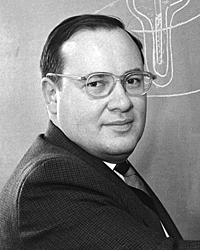Arthur Leonard Schawlow facts for kids
Quick facts for kids
Arthur Leonard Schawlow
|
|
|---|---|

Arthur Leonard Schawlow in 1981
|
|
| Born | May 5, 1921 Mount Vernon, New York, U.S.
|
| Died | April 28, 1999 (aged 77) Palo Alto, California, U.S.
|
| Nationality | American |
| Alma mater | University of Toronto |
| Known for | Laser spectroscopy Laser cooling Schawlow–Townes approximation |
| Spouse(s) | Aurelia Townes (m. 1951; 3 children) |
| Awards | Stuart Ballantine Medal (1962) IEEE Morris N. Liebmann Memorial Award (1964) Richtmyer Memorial Award (1970) Frederic Ives Medal (1976) Marconi Prize (1977) Nobel Prize for Physics (1981) National Medal of Science (1991) |
| Scientific career | |
| Fields | Physics |
| Institutions | Bell Labs Columbia University Stanford University |
| Doctoral advisor | Malcolm Crawford |
| Doctoral students | Antoinette Taylor |
Arthur Leonard Schawlow (born May 5, 1921 – died April 28, 1999) was an American physicist. He is famous for helping to invent the laser. He worked with Charles Townes to create this important device.
Schawlow had a key idea that Townes missed. He thought of using two mirrors to make the laser work. This helped turn the "maser" (which uses microwaves) into a laser (which uses visible light). In 1981, he won the Nobel Prize in Physics. He shared it with Nicolaas Bloembergen and Kai Siegbahn. They won for their work using lasers to study the energy levels of atoms very precisely.
Contents
Arthur Schawlow's Life Story
Arthur Schawlow was born in Mount Vernon, New York, in the United States. His mother, Helen, was from Canada. His father, Arthur Schawlow, was an immigrant from Riga, which was then part of the Russian Empire.
When Arthur was three years old, his family moved to Toronto, Ontario, Canada.
Early Life and Education
Arthur was a very smart student. He finished high school at Vaughan Road Academy when he was just 16. He received a scholarship to study science at the University of Toronto.
After getting his first degree, he continued his studies at the University of Toronto. His studies were paused because of World War II. After the war ended, he started working on his Ph.D. degree. His professor was Malcolm Crawford.
In 1949, he moved to the United States. He took a special research position at Columbia University. There, he worked with Charles H. Townes, who would later become his brother-in-law and co-inventor.
Career in Science
In 1951, Schawlow started working at Bell Labs. This was a famous research company. He stayed there for ten years.
In 1961, he became a professor at Stanford University. He taught and did research at Stanford until he retired in 1996. Even after retiring, he continued to be involved with the university.
His main research was in optics, which is the study of light. He focused on lasers and how to use them to study materials. This field is called spectroscopy. He also studied other areas like superconductivity and nuclear magnetic resonance.
Developing the Laser
Arthur Schawlow and Charles Townes wrote an important book together called Microwave Spectroscopy in 1955.
In 1958, they published a very important paper. It explained how to design and operate "optical masers," which we now call lasers. While they were the first to publish this theory, another scientist named Gordon Gould also had similar ideas around the same time. The first working laser was actually built in 1960 by Theodore Maiman.
In 1991, a company called NEC Corporation and the American Physical Society created a special award. It's called the Arthur L. Schawlow Prize in Laser Science. This prize is given every year to scientists who make great discoveries using lasers.
Personal Life and Family
In 1951, Arthur Schawlow married Aurelia Townes. She was the younger sister of his colleague, Charles Townes. They had three children: Arthur Jr., Helen, and Edith.
Their son, Arthur Jr., had autism. He had difficulty speaking. Arthur Schawlow and another professor at Stanford, Robert Hofstadter, both had autistic children. They worked together to find ways to help children with autism.
Arthur Jr. lived in a special center for people with autism. Later, Schawlow helped create a place in Paradise, California, to care for people with autism. In 1999, shortly before he passed away, this center was named the Arthur Schawlow Center in his honor.
Arthur Schawlow was a Christian. He also loved traditional American jazz music. He was a big fan and collected jazz recordings. He also supported groups that played this type of music.
Arthur Schawlow died from leukemia in Palo Alto, California, on April 28, 1999. He was 77 years old.
Awards and Honors
- 1962 - Stuart Ballantine Medal
- 1963 - Young Medal and Prize, for important research in optics
- 1970 - Elected to the American Academy of Arts and Sciences
- 1970 - Elected to the National Academy of Sciences
- 1976 - Awarded the Frederic Ives Medal by OSA
- 1981 - Nobel Prize for Physics
- 1983 - Golden Plate Award of the American Academy of Achievement
- 1984 - Elected to the American Philosophical Society
See also
 In Spanish: Arthur Leonard Schawlow para niños
In Spanish: Arthur Leonard Schawlow para niños
- Optical Society of America#Past Presidents of the OSA

